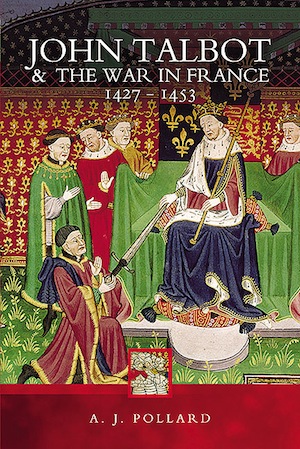
A.J. Pollard
John Talbot and the War in France 1427-1453
Barnsley: Pen & Sword Books Limited, 2005. 166pp. us£10.99/$21.99. ISBN-10: 9781844152476.
In the mid-1960s, research was under way for two doctoral dissertations concerning John Talbot, first earl of Shrewsbury. At Bristol University in the UK, A. J. Pollard took on the study the baronial Talbot family in the fifteenth century, while at Princeton University in the US, Reginald Brill sought to explore Anglo-French warfare between the death of King Henry V (1422) and the Truce of Tours (1444) through the military activities of John Talbot. It would come to pass that Pollard, not Brill, would publish the examination of the military career of John Talbot in the closing decades of the Hundred Years’ War. There is a small irony here as Brill saw himself as a military historian while Pollard does not see himself as one. In the late 1970s Pollard wrote the typescript of the book currently under review, using the research for and some of the text of his 1968 doctoral thesis on “The Family of Talbot, Lords Talbot and Earls of Shrewsbury in the Fifteenth Century,” plus the scholarship of others during the intervening decade; he completed the book in 1980. While the text was in press, he continued to make modifications until publication in 1983. For the republication by Pen & Sword Books in 2005, he added the “Preface to Second Edition,” in which is related the history of the book’s development and discusses the scholarship since 1983 that touches upon the book’s themes.
With the exception of chapter 1, John Talbot and the War in France 1427-1453 contains two kinds of chapters. The first type are those narrating Talbot’s military biography in chronological periods: 1427-36 (ch. 2), 1436-50 (ch. 4), and 1450-53 (ch. 8). The second type is four interspersed chapters exploring various topics related to Talbot’s activities: Lancastrian Normandy’s organization (ch. 3), Talbot and his soldiers (ch. 5), Talbot and war profits (ch. 6), and Talbot and chivalry (ch. 7). Pollard’s chapter organization allows the reader several approaches for reading his book. For a continuous narrative of Talbot’s life as a soldier, one simply reads chapters 1, 2, 4, and 8. For an in-depth discussion in the topical chapters, the reader just turns to the particular chapter that is of interest, and each topical chapter stands well by itself. Pollard’s organization is quite appealing in that it presents the reader with an alternative to just reading the book straight through cover-to-cover.
Regardless of how one approaches the book, the reader will curiously find little concerning Talbot’s life in his home country, England. Little is said about his involvement in the rule of either England or his own estates. Pollard points out that when in England, Talbot’s behavior was rather violative and grasping. This sort of behavior, however, was more the norm than the exception in fifteenth-century England after the death of Henry V, as can also be seen, for example, in the career of Sir John Fastolf. Although Talbot was often at odds with Fastolf for his having conducted a fighting escape from the English defeat at Patay (18 July 1429), while Talbot was left to be captured by the French, both men were similar in being more than just English captains in Lancastrian France. Their lives were quite varied, being merchants, owning ocean-going ships, holding large tracts of land in France, advising the government on political and military matters as well as being huge creditors of the English crown. Talbot’s military actions embodied the tension between the chivalric ideals of the knightly class and the grimness of late medieval warfare in the closing years of the Hundred Years’ War. The values of the former continually clashed with the realities of the latter. Somehow, through the seeming never ending grinding of the day-to-day military demands, Talbot kept going and answering each challenge with varying success.
Although contemporary Frenchmen referred to him as “Le Roi Talbot” with the exception of his lieutenancy of Guyenne in 1452-53, Talbot never held supreme office in France. Always he acted as a subordinate to others though usually as their leading military commander. His superiors did the governing while he did the fighting. Whether he began as a hard ruthless man, he, like Fastolf, became one who was often ruled by a harsh self-interest. Talbot’s brutal behavior both abroad and at home was more the rule than the exception in the reign of Henry VI, and Pollard shows this in Talbot’s case. Despite losing his two greatest battles, Patay on 18 June 1429 and Castillon on 17 July 1453, Talbot’s ability to conduct war as an administrator and a combat soldier was largely responsible for the quotidian English maintenance of Henry V’s conquests in Northern France as detailed in this book. Thanks to Pen & Sword Books, today’s readers may obtain at a very reasonable price this new edition of Pollard’s still highly relevant study that lets the reader see how John Talbot accomplished this feat.
Note that Pollard’s doctoral thesis is available on the Internet through British Library EThOS.
